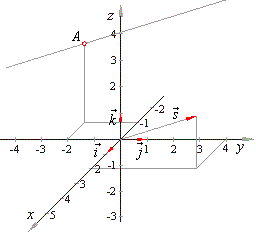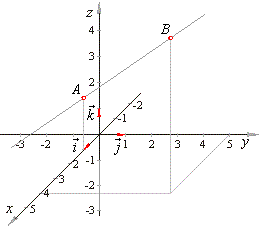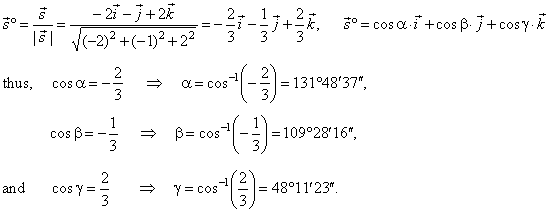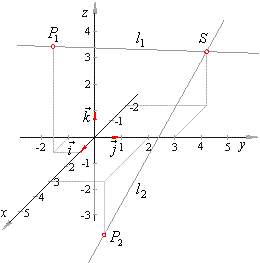|
| Coordinate
Geometry (Analytic Geometry) in Three-dimensional Space |
|
|
Points, lines and planes in three-dimensional coordinate
system represented by vectors |
 A
line in a 3D space examples
A
line in a 3D space examples |
 Angle between lines
Angle between lines
|
 Condition for intersection of two
lines in a 3D space
Condition for intersection of two
lines in a 3D space
|
|
|
|
|
|
|
|
| A
line in the 3D space examples |
| Example:
Determine equation of a line passing through the point
A(-1,
-2, 3) and which is parallel to the
vector
s
= 2i + 4j + 2k.
|
| Solution: |
| By plugging coordinates of the given point A
and
the components of the direction vector s
into equation of a line |
 |
| obtained is |
 |
|
 |
|
|
| Example:
Find the equation of a line passing through the points,
A(1,
0, 2) and B(4,
5, 6).
|
| Solution: |
| By plugging coordinates of the given points into equation of a line
through two given points |
 |
| obtained is |
 |
| Plug the coordinates of both points into obtained equation to verify
the result.
|
|
 |
|
|
| Example:
Find the angles that a line
|
 |
forms with coordinate
axes
|
|
| Solution: The unit vector of the direction vector
s
= -2i
-
j + 2k |
 |
|
| Angle between lines
|
| Angle between two lines |
 |
equals the |
|
| angle
subtended by direction vectors, s1
and s2
of the lines |
|
|
| For the lines that do not intersects, i.e., for the skew lines (such as two lines not lying on the same plane in
space), assumed is the angle between lines that are parallel to given lines that intersect. |
| That is, the initial
points of their direction vectors always can be brought to the same point by translation. |
|
| Condition for intersection of two
lines in a 3D space
|
| Two lines in a 3D space can be parallel, can intersect or can be skew lines. |
| Two parallel or two intersecting
lines lie on the same plane, i.e., their direction vectors, s1
and s2 are coplanar with the vector
P1P2
= r2 -
r1 drawn
from the point P1,
of the first line, to the point
P2 of the second line. |
| Therefore, the scalar triple product of these
vectors is zero, |
|
|
|
| Example: Given are lines, |
 |
examine whether |
|
| lines intersect or are skew lines, and if intersect, find the intersection point and the angle between lines. |
| Solution:
|
| In the given equations of lines, |
|
P1(1, -1,
4) and
s1
= -3i + 4
j -
2k,
|
| and |
|
P2(3, 2, -2)
and s2
= -5i +
j + 4k |
| therefore,
vector |
| P1P2
= r2 -
r1
= 2i + 3 j -
6k. |
| Let
examine whether the lines intersect |
|
 |
|
 |
| therefore,
the lines intersect. |
| Intersection of two lines is a point, coordinates of
which satisfy both equations therefore, solutions, x,
y
and z of the equations,
l1
and l2
are the coordinates of the intersection point, that is |
 |
| Thus, given lines intersect at the point
S(-2,
3, 2). |
| The angle between
direction vectors, s1
and s2
of the lines, we calculate from the formula |
 |
|
|
|
|
|
|
|
|
|
|
|
| Pre-calculus contents
J |
|
|
 |
|
| Copyright
© 2004 - 2020, Nabla Ltd. All rights reserved. |